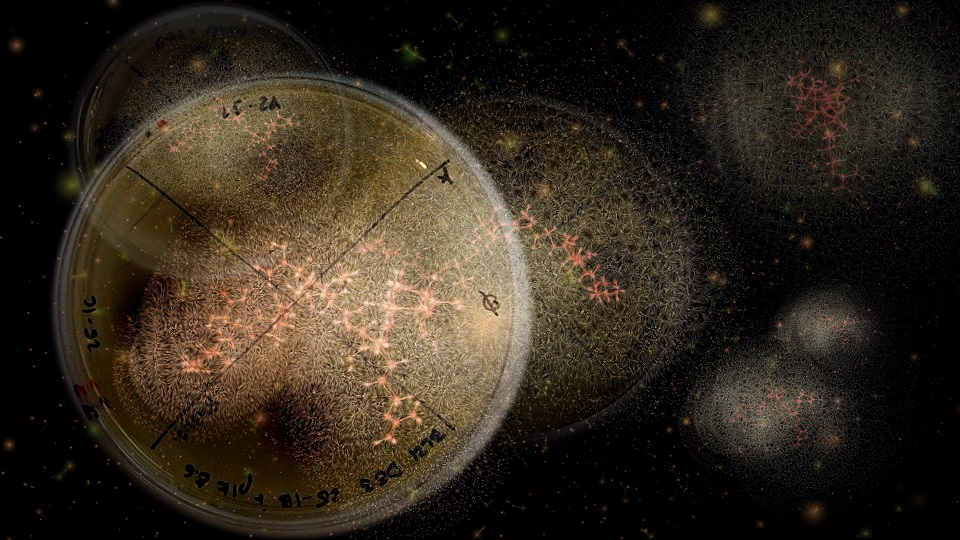

Philosophers’ Stone is an artistic project related to the scientific research of the iGEM Heidelberg Team, EilsLabs/DKFZ/University of Heidelberg (Grand Prix in iGEM 2013 competiton!) 2013.igem.org/Team:Heidelberg
What is the philosophers’’ stone in the age of
molecular and synthetic biology?
The
special role is played by ‘biobricks’- designed standard biological modules
based on short DNA sequences, used for designing and creating bigger biological
circuits with defined functions. The research is crucial for nanotechnology and
medicine, and in the future, for creating new synthetic forms of life which
genome will be based on standardised parts.
The scientific project was
inspired by the bacterium Delftia acidovorans, discovered in Australia and known
for generating a non-ribosomal peptide called Delftibactin used to detoxify
soluble gold and to create golden nanoparticles. By
experimenting with E-coli bacteria, scientists aim to
verify the potentiality of non-ribosomal peptides synthesis not only in
recycling gold from electronic waste but also in pharmaceutical and basic
research.
The philosophers' stone may well be perceived as a
quintessence of human greed and hubris, but also as an embodiment of eve-lasting
human passion to comprehend and govern natural processes. The Intersection of
cultural and scientific imageries/imaginaries as well as rich cultural roots of
contemporary scientific practices became the inspiration for my artistic work.
The 3D stereoscopic narrative is accompanied by a hologram-like animation.
PHILOSOPHERS' STONE
3 d stereoscopic narrative: stills (one channel)
NIGREDO or blackness.
For alchemists,the first step towards lapis philosophorum was Nigredo – blackness. In this phase all ingredients where subjected to putrefaction or decomposition becoming massa confusa. a uniform black essence or chaos.
in my film: Nigredo is the process in which computer
waste, people and bacteria merge into a unified digital matter.
ALBEDO
whiteness,
process of purification
in film: process in which particles of massa confusa start to form an atomic structure of Delftibactine, slowly creating a complicated virtual structure
CITRINITAS
yellowness;
the transmutation of silver into gold,
the solar dawn and awakening,
in
film:
the cloudy model
of
Delftibactin is transformed into a precious
and desired gold, a symbol of the highest value, immortality and beauty.
RUBEDO
In
film
the piece of gold, made of data,
scientists’ notes and records, slowly gets diffused into particles - dispersed
carriers or seeds of information,
the
process of achieving Philosophers’ Stone concluded in MULTIPLICATION and PROJECTION
(into the world) – aiming
to increase the potency of lapis
philosophorum.
In film
dispersed particles
start to form copies of the peptide, stems of philosophers’ stone.
They are developing in virtual Petri dishes, which towards the end, form a symbol of the tree of life.
The tree of life, identified often as a tree of knowledge and an elixir of life, brings together in its diagram values represented by the
philosophers' stone and a way of development from the roots-foundations through beauty, understanding and knowledge to the crown of wisdom.
The lack of fulfilment of the Grand Work, the impossibility of reaching out to the fullness of knowledge and the illusion of cognition contain the truth
about the human predicament and limitations. Yet
part of this truth is inherent in the incessant attempts to overcome limitations
and to launch new thinking structures.
Today, at a time of enormous advances of science, information flow and interpersonal communication on a scale unprecedented in human history,
we harbour hopes of going beyond the chaos of individual pursuits and contexts towards more holistic qualities in human consciousness and activity.
However these hopes are overshadowed by fears of misuse of the power provided by knowledge, lack of control over complex systems or
assignment of moral responsibilities to machines.